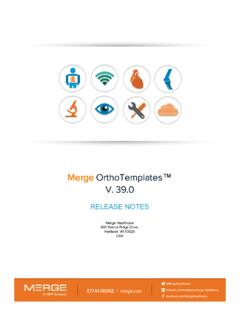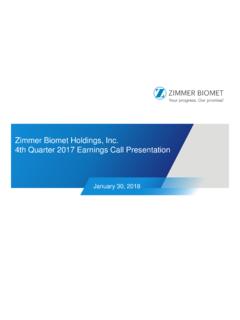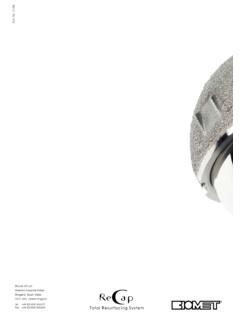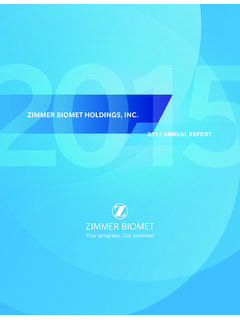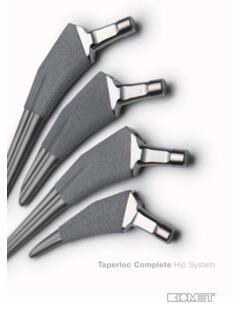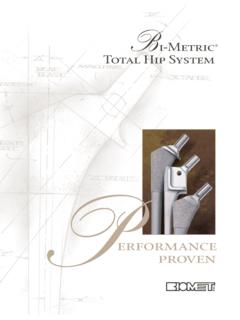Transcription of Taperloc Op Tech - Orthoteers
1 05/04 References 1. McLaughlin , Lee , Total Hip Arthroplasty with an Uncemented Femoral Component JBJS [Br.}, 1997, 79B:900 907. 2. Hozack , et al., Primary Cementless Hip Arthroplasty with a Titanium Plasma Sprayed Prosthesis CORR Number 33-3, December 1996, 217 225. 3. Hozack W., Ten Year Experience with a Wedge-Fit Stem Presented at Crucial Decisions in TJA and Sports Medicine, Bermuda, 1998. 4. McLaughlin , Plasma Sprayed Porous-Coated Total Hip Arthroplasty: A 13 Year Survivorship Analysis in Patients Age 50 and Under Presented at the 63rd AAOS, San Francisco, 1997. 5. Rothman and Hozack , Hydroxyapatite-Coated Femoral Stems JBJS, 78 A, No. 3, March 1996, 319 324.]
2 6. Sharkey , et al., Initial Stability of a Collarless Wedge-Shaped Prosthesis in the Femoral Canal Seminars in Arthroplasty, Vol. 1, No. 1, July 1990, 87 90. 7. Peyton R., et al., Uncemented Primary Total Hip Arthroplasty in Octogenarians Presented at Crucial Decisions in TJA and Sports Medicine, Bermuda, 1999. 8. Head , et al., Comparison of Polyethylene Wear in Machined Versus Molded Polyethylene Liners in RingLoc Acetabular Cups Presented at Crucial Decisions in TJA and Sports Medicine, Bermuda, 1999. 9. Clare , Gustafson A., and Good V., Howard and Irene Peterson Tirbology Laboratory, Department of Orthopedics, Loma Linda University Medical Center. Abstract presented at 7th Annual Conference on Techniques and Science for Successful Joint Arthroplasty, Burlington, Vermont, October 5 6, 1995.
3 10. Schroeder and Pozorski , Hip Simulator Wear Testing of Isostatically Molded UHMWPE, Effect of EtO and Gamma Irradiation 42nd Annual Meeting, Orthopaedic Research Society, February 19 22, 1996, Atlanta, Georgia. 11. Rao et al., Immediate Weight Bearing After Uncemented Total Hip Arthroplasty Clinical Orthopaedics, April 1998, 156 162. 12. Blunn et al., Wear in Retrieved Condylar Knee Arthro-plasties Journal of Arthroplasty, Vol. 12, No. 3, 1997, 281 290. 13. Data derived from Rosner , Postak , Greenwald , Cup/Liner Conformity of Modular Acetabular Design Scientific Exhibit presented at the AAOS, 62nd Annual Meeting, Orlando, FL 1995. 14. Fehring , et al.
4 , Motion at the Modular Acetabular Shell-Liner Interface: A Comparative Study Scientific Exhibit presented at the AAOS 63rd Annual Meeting. 15. Two-Piece Acetabular Cups, Scientific Exhibit presented at the AAOS, 59th Annual Meeting, San Francisco, CA, 1992. Data derived from Postak , Tradonsky S., Froimson , Greenwald ; Performance Characteristics of Two-Piece Acetabular Cups Series II Scientific Exhibit presented at the 63rd Annual Meeting, Atlanta, GA, 1996. This data is the property of the Orthopaedic Research Laboratories of the Mt. Sinai Medical Center, Cleveland, OH. The reproduction and distribution of this data are restricted. 16. Markel , et al., Initial Scratch Fit Stability of Acetabular Cups: Comparison of Three Porous Coated Systems Presented at the 10th Annual Symposium of the International Society of Technology in Arthroplasty, San Diego, , RingLoc , ArCom , Bi-Metric , Integral , Max-Rom and Mallory-Head are trademarks of Biomet, Inc.
5 Integrity is a registered trademark of Kirschner Medical Corporation, a Biomet, Inc. other trademarks are not associated with Biomet, Design Rationale & Surgical Technique ContentsDesign Rationale Total hip system .. Offset Variations .. Rotational Fixation.. Change in Stiffness.. Implant Stability and Fixation .. Plasma Spray Porous Coating.. Consistent Results.. RingLoc Acetabular Series .. Technique Taperloc Surgical Technique .. Modular Head Options.. Taperloc Parts Listing.. References.. Total Hip SystemDesign Rationale & Surgical TechniqueDisclaimerBiomet Merck Ltd, as the manufacturer of this device, does not practice medicine and does not recommend this or any other surgical technique for use on a specific patient.
6 The surgeon who performs any procedure is responsible for determining and utilising the appropriate techniques for such procedure for each individual patient. Biomet Merck Ltd is not responsible for selection of the appropriate surgical technique to be utilised for and individual Total Hip SystemDesign Rationale & Surgical Technique3P e r f o r m a n c e P r o v e nTaperLoc Total Hip SystemThe Taperloc femoral components evolved from the European philosophy of proportionately designed flat tapered stems, which have been used widely and effectively throughout Europe during the past two decades. From an engineering perspective, there are many theoretical advantages of a flat wedge-shaped collarless design, such as excellent rotational stability and load transfer to the femur.
7 A multitude of clinical studies has concluded that these theoretical advantages do result in less pain and better ,2,4,6 Offset VariationsIntroduced in 1983, the Taperloc hip had the first primary femoral component offered in the United States with a lateral offset option. Availability of a lateral offset design allows the surgeon to enhance stability without lengthening the leg (Figure 1). The capability of increasing the offset by 6mm helps reduce the likelihood of dislocation. With most systems, lengthening the leg is the only means available to achieve this enhanced stability. Long-term survivorship with less thigh pain, stress shielding and Survivorship in a series of 4,750 cases over a twelve year Survivorship at 13 years with 100 consecutive implants and 100% follow-up.
8 Average patient age: 37 Distal Osteolysis at 8 1 Regular OffsetLateral Offset5 Taperloc Total Hip SystemRotational FixationA flat wedged design used in the typical ovoid femoral canal provides better rotational stability than those femoral designs based on a round intramedullary rod (Fig. 2). It is generally accepted that rotational stability is the critical parameter for satisfactory fixation and effective pain relief. In a series of tests, Sharkey et al. found the Taperloc stem to have excellent stability with both axial and rotational in StiffnessThe tapered titanium geometry, inherent in the Taperloc stem design, allows for a gradual transition in stiffness from the upper femur, which contains the implant, to the mid femur, which is more flexible (Fig.)
9 3a). With the use of a cobalt chrome intramedullary rod, there will be a more sudden change in stiffness from the extremely rigid upper portion of the femur containing the rod to the more distal portion (Fig. 3b). In fact, the tapered design concept has resulted in a consistently low incidence of thigh ,2,4 Implant Stability and FixationThe use of a collarless design in the Taperloc hip tends to allow for self-seating of the implant and achievement of optimal rotational stability, immediately after implantation. The Taperloc collarless stem design leads to dependable fixation and an extremely low rate of Total Hip SystemS i m p l y t h e b e s t4 Fig. 2 Fig. 3 Flat WedgeCylindrical DesignAB5 Design Rationale & Surgical TechniquePlasma Spray Porous CoatingWhen Biomet originally considered ways to apply a porous coating on load-bearing implants, sintering of titanium alloy beads was considered but never implemented.
10 Cobalt chrome alloy was also considered, but the greater biocompatibility and superior mechanical and material properties of titanium alloy made it the material of choice. In the early 1980 s, a company founder obtained military literature, which described plasma spraying of dense titanium coatings without degradation of the substrate s fatigue s proprietary plasma spray application is unique due to the fact that only the titanium alloy powder used to create the coating is heated, not the substrate of the implant which can lower its mechanical properties. Randomly shaped particles tend to flatten upon impact with the substrate. This generates a random distribution of pore size between 100 and 1,000 microns providing a larger contact area between particles and substrate.
